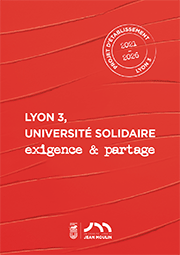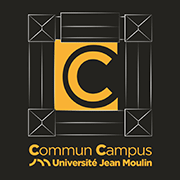AccueilRechercheProgrammes et productions scientifiquesThèsesThèses soutenuesThèses soutenues - 2006-2021Thèses soutenues - 2017
-
Partager cette page
- Recherche,
CHARLAS Joseph-Michel
Cléricalisme et anticléricalismes à Lyon, de la Commune à la Première Guerre mondiale (1870-1914)
Publié le 20 décembre 2017 – Mis à jour le 13 décembre 2018
Thèse en Histoire mention histoire religieuse, politique et culturelle, soutenue le 23 octobre 2017.
Les quarante-cinq premières années de la Troisième République se caractérisent par une politique de la?cisation touchant de nombreux domaines, à commencer par l’éducation, politique qui culmine en 1905 avec la loi de Séparation des ?glises et de l’?tat. La ville de Lyon, qui avait connu durant les deux premiers tiers du XIXème siècle une renaissance particulièrement forte du catholicisme, se manifestant par la création d’?uvres dynamiques, se voit confrontée en retour à une vague particulièrement puissante d’anticléricalisme. La confrontation des deux groupes idéologiquement opposés, que l’on peut nommer ? clérical ? et ? anticlérical ?, détermine toute une succession de crises, d’accalmies, de recompositions, dont les spécificités lyonnaises ne pas toujours liées à celles du contexte national. Dans ses aspects concrets, cette lutte n’est pas per?ue de la même fa?on chez tous ceux qui se rassemblent autour de l’étiquette ? anticléricale ? : les ouvriers de la Guillotière n’ont pas les mêmes griefs à formuler contre le clergé que les radicaux du ? Comité de la rue de Gr?lée ?. Néanmoins, autant l’anticléricalisme reste assez simple à définir, autant le cléricalisme se révèle plus difficile à appréhender : il dépend d’abord du regard de l’autre, notamment de l’anticlérical. Les diverses manifestations de défense religieuse d’un catholicisme qui se per?oit alors volontiers comme une citadelle assiégée, les multiples attaques contre le clergé, voire contre la religion, des hommes au pouvoir, s’inscrivent à Lyon, sur la longue durée, dans le droit fil d’une série de luttes, d’insurrections et de répressions, dont chaque camp revendique - ou non - la postérité idéologique.
One of the main features of the first forty five years of the Third Republic is a policy of secularization in many fields, beginning with education and reaching its climax in 1905 when the law on the separation between church and state was passed (given the French context at the time, it especially targeted the catholic church). During the first two thirds of the XIXth century Lyons had known a strong revival of Catholicism which manifested itself by the creation of dynamic charitable organizations. The town then had to face a sudden increase of anticlericalism. The confrontation between two groups that were politically opposed – let us name them “clerical” and “anticlerical” – sparked crisis after crisis, followed by lulls and reconstructions, all these being sometimes different from what was happening at the national level, due to the particular characteristics of the town. In concrete terms not all that had gathered under the banner of anti-clericalism held the same opinion about the struggle: the workers in the district of La Guillotière did not hold the same grievances against the clergy as the radicals in the “rue de Gr?lée committee”. Yet, although anticlericalism can be easily defined, clericalism proves more difficult to apprehend: in the first place it depends on the perception the others, and more specifically those who support the anticlerical faction, have of us. Catholicism then tends to see itself as a besieged fortress and the different manoeuvres set up to defend its religion, the numerous attacks against the clergy, even against religion from men in power are, in Lyons, quite in keeping with a long succession of struggles, insurrections and suppressions of which each side claims - or does not claim - the ideological posterity.
Mots-clés : cléricalisme, anticléricalisme, Lyon, congrégations, catholicisme social, démocratie chrétienne, esprit nouveau, dreyfusards, ralliement, nationalisme
Keywords : clericalism, anticlericalism, Lyons, religious congregations, christian socialism, christian democracy, change of spirit (easing of the tension between anticlerical republicans and the catholics), Dreyfus supporters, rallying to the Republic, nationalism
Directeur(s).trice(s) de thèse : M. Jean-Dominique DURAND
One of the main features of the first forty five years of the Third Republic is a policy of secularization in many fields, beginning with education and reaching its climax in 1905 when the law on the separation between church and state was passed (given the French context at the time, it especially targeted the catholic church). During the first two thirds of the XIXth century Lyons had known a strong revival of Catholicism which manifested itself by the creation of dynamic charitable organizations. The town then had to face a sudden increase of anticlericalism. The confrontation between two groups that were politically opposed – let us name them “clerical” and “anticlerical” – sparked crisis after crisis, followed by lulls and reconstructions, all these being sometimes different from what was happening at the national level, due to the particular characteristics of the town. In concrete terms not all that had gathered under the banner of anti-clericalism held the same opinion about the struggle: the workers in the district of La Guillotière did not hold the same grievances against the clergy as the radicals in the “rue de Gr?lée committee”. Yet, although anticlericalism can be easily defined, clericalism proves more difficult to apprehend: in the first place it depends on the perception the others, and more specifically those who support the anticlerical faction, have of us. Catholicism then tends to see itself as a besieged fortress and the different manoeuvres set up to defend its religion, the numerous attacks against the clergy, even against religion from men in power are, in Lyons, quite in keeping with a long succession of struggles, insurrections and suppressions of which each side claims - or does not claim - the ideological posterity.
Mots-clés : cléricalisme, anticléricalisme, Lyon, congrégations, catholicisme social, démocratie chrétienne, esprit nouveau, dreyfusards, ralliement, nationalisme
Keywords : clericalism, anticlericalism, Lyons, religious congregations, christian socialism, christian democracy, change of spirit (easing of the tension between anticlerical republicans and the catholics), Dreyfus supporters, rallying to the Republic, nationalism
Directeur(s).trice(s) de thèse : M. Jean-Dominique DURAND
Membres du jury :
M. Jacques-Olivier BOUDON, Rapporteur, Professeur des universités, Université Paris-Sorbonne,
M. Jean-Dominique DURAND, Professeur des universités émérite, Université Jean Moulin Lyon 3,
Mme Jacqueline LALOUETTE, Professeure émérite, Université de Lille 3,
Mme Catherine MAURER, Rapporteur, Professeure des universités, Université de Strasbourg,
M. Daniel MOULINET, Professeur, Université catholique de Lyon,
M. Christian SORREL, Professeur, Université Lumière Lyon 2.
Président.e du jury : M. Christian SORREL
Equipe d'accueil : LARHRA
M. Jean-Dominique DURAND, Professeur des universités émérite, Université Jean Moulin Lyon 3,
Mme Jacqueline LALOUETTE, Professeure émérite, Université de Lille 3,
Mme Catherine MAURER, Rapporteur, Professeure des universités, Université de Strasbourg,
M. Daniel MOULINET, Professeur, Université catholique de Lyon,
M. Christian SORREL, Professeur, Université Lumière Lyon 2.
Président.e du jury : M. Christian SORREL
Equipe d'accueil : LARHRA
Décision : Admis
Documentation
Mise à jour : 13 décembre 2018







